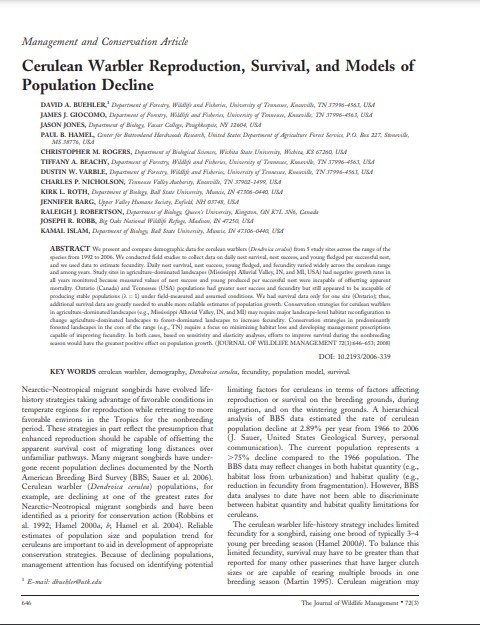Cerulean Warbler Reproduction, Survival, and Models of Population Decline
Bosque Modelo:
Eastern Ontario
Temática:
Desarrollo humano
Tipo de documento:
Artículo científico
Resumen
We present and compare demographic data for cerulean warblers (Dendroica cerulea) from 5 study sites across the range of the species from 1992 to 2006. We conducted field studies to collect data on daily nest survival, nest success, and young fledged per successful nest, and we used data to estimate fecundity. Daily nest survival, nest success, young fledged, and fecundity varied widely across the cerulean range and among years. Study sites in agriculture-dominated landscapes (Mississippi Alluvial Valley, IN, and MI, USA) had negative growth rates in all years monitored because measured values of nest success and young produced per successful nest were incapable of offsetting apparent mortality. Ontario (Canada) and Tennessee (USA) populations had greater nest success and fecundity but still appeared to be incapable of producing stable populations (k ¼ 1) under field-measured and assumed conditions. We had survival data only for one site (Ontario); thus, additional survival data are greatly needed to enable more reliable estimates of population growth. Conservation strategies for cerulean warblers in agriculture-dominated landscapes (e.g., Mississippi Alluvial Valley, IN, and MI) may require major landscape-level habitat reconfiguration to change agriculture-dominated landscapes to forest-dominated landscapes to increase fecundity. Conservation strategies in predominantly forested landscapes in the core of the range (e.g., TN) require a focus on minimizing habitat loss and developing management prescriptions capable of improving fecundity. In both cases, based on sensitivity and elasticity analyses, efforts to improve survival during the nonbreeding season would have the greatest positive effect on population growth.
Información Bibliográfica
Autor:
Buehler DA, Giocomo JJ, Jones J, Hamel PB, Rogers CM, et al.
Revista:
Journal of Wildlife Management
Año:
2008
N°:
3
País :
Canadá
Páginas:
646 - 653
Volumen:
72
Idioma:
Ingles
Palabras claves
cerulean warbler, demography, Dendroica cerulea, fecundity, population model, survival.





